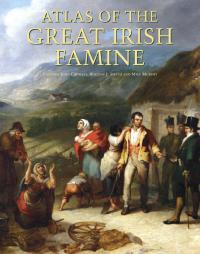
John Crowley, William J. Smyth and Mike Murphy (eds)
(Cork University Press, €59)
ISBN 9781859184790
When I got my review copy of the Atlas of the Great Irish Famine, I was startled by the heft of the book; this is a seriously weighty tome! In spite of its cumbersome format, however, Cork University Press is to be congratulated for a fine publication with excellent production values. As far as content is concerned, ‘it does exactly what it says on the tin’: this is an atlas, compiled and edited by geographers. According to the introduction, the cartographic journey to the Atlas of the Great Irish Famine ‘began almost twenty years ago with a discussion in the Department of Geography, University College Cork’. Anyone wishing to study or research the Famine will discover a fascinating assembly of relevant material contained in the maps, diagrams, graphs, illustrations, statistics and essays that adorn this publication. There is one major drawback, however—the absence of a proper index. There is, as you would expect from geographers, an index of places, but the reader will find this less than helpful when trying to make sense of the multitude of facts contained in the atlas.

